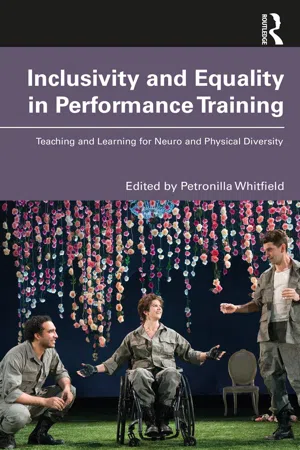
Inclusivity and Equality in Performance Training
Teaching and Learning for Neuro and Physical Diversity
Petronilla Whitfield, Petronilla Whitfield
- 324 páginas
- English
- ePUB (apto para móviles)
- Disponible en iOS y Android
Inclusivity and Equality in Performance Training
Teaching and Learning for Neuro and Physical Diversity
Petronilla Whitfield, Petronilla Whitfield
Información del libro
Inclusivity and Equality in Performance Training focuses on neuro and physical difference and dis/ability in the teaching of performance and associated studies. It offers 19 practitioners' research-based teaching strategies, aimed to enhance equality of opportunity and individual abilities in performance education.
Challenging ableist models of teaching, the 16 chapters address the barriers that can undermine those with dis/ability or difference, highlighting how equality of opportunity can increase innovation and enrich the creative work. Key features include:
-
- Descriptions of teaching interventions, research, and exploratory practice to identify and support the needs and abilities of the individual with dis/ability or difference
-
- Experiences of practitioners working with professional actors with dis/ability or difference, with a dissemination of methods to enable the actors
-
- A critical analysis of pedagogy in performance training environments; how neuro and physical diversity are positioned within the cultural contexts and practices
-
- Equitable teaching and learning practices for individuals in a variety of areas, such as: dyslexia, dyspraxia, visual or hearing impairment, learning and physical dis/abilities, wheelchair users, aphantasia, attention-deficit/hyperactivity disorder and autistic spectrum.
The chapter contents originate from practitioners in the UK, USA and Australia working in actor training conservatoires, drama university courses, youth training groups and professional performance, encompassing a range of specialist fields, such as voice, movement, acting, Shakespeare, digital technology, contemporary live art and creative writing.
Inclusivity and Equality in Performance Training is a vital resource for teachers, directors, performers, researchers and students who have an interest in investigatory practice towards developing emancipatory pedagogies within performance education.
Preguntas frecuentes
Información
1 Introduction
Introduction
Because disability is still not universally understood as a civil rights initiative, the colonial past of arts experiences for disabled youth might have escaped your notice. Motivated by charity – ‘helping the unfortunate’ – rather than fairness or equity, the common colonial model of theatrical instruction for disabled people has been one of nondisabled caregivers, some theatrical professionals […] offering performing arts as a recreational and normalizing activity for segregated, institutionalized groups […]. The difficulty is that the visibility of such programs makes the idea of a disabled youth seeking competitive training in the arts almost unthinkable.(Unpublished version of Lewis 2010)
Removing the Barriers to Difference and Disability
[R]esearch conducted by The Stage has revealed the extent of under-representation of disabled students at the UK’s leading drama schools. Last year, just 1% of graduates from major drama schools declared a physical impairment – covering mobility, sight or hearing impairments. The most up-to-date government figures, from 2016, state that 11% of people in the general population declared a mobility impairment, 3% declared a vision impairment and 3% had a hearing impairment.(Masso 2018)
Barred from conventional university theatre and performance departments […] and barred too from vocational drama schools because these actors do not fit easily within the traditional training model, the aspiring actor who has a learning disability has almost no access to appropriate training.(Palmer and Hayhow 2008:176–178)
In my experience as a working actress, producer, and theatre educator for the past 30 years, in theatres ranging from grassroots to Equity, and in venues from street fairs to prime-time television, I have found that these two positions – one, that the disabled actor is unemployable; and, two, that physically disabled actors will not be able to master significant areas of actor training-- are still widely held, if seldom publicly proclaimed.
Índice
- Cover
- Half Title
- Title Page
- Copyright Page
- Dedication
- Contents
- List of illustrations
- List of tables
- Foreword by Victoria Lewis
- Acknowledgments
- List of contributors
- 1 Introduction
- 2 Acting Training and Instruction for Wheelchair-Using Artists
- 3 Acting Without Imagery: Aphantasia in the Theater Classroom
- 4 Twelve Steps Toward an Anti-Discriminatory Approach to Neurodivergence in Actor Training
- 5 Disabling Actions and Enabling Actors: Exploring the Method of Actioning the Text for Actors with Dyslexia
- 6 Exploring Digital Technology to Enable Acting Students with Dyslexia in their Reading of Shakespeare
- 7 How Can Imagery, Sounds, Textures and Other Creative Mediums Help an Actor with Dyslexia Understand and Connect to Shakespeare's Text?
- 8 Somatic and Spatial Approaches to Essay Writing for Drama Students with Dyslexia
- 9 When I Can't ‘See You at the Theater’: Creating Inclusive Processes for Vision-Impaired Performers
- 10 Politicized Identity: Developing a Dialectical Relationship between Disability and Ability
- 11 ‘Embodied Voice’ and Inclusivity: Ableism and Theater Voice Training
- 12 Experience as Curriculum: Developing an Intuitive, Affective, Affirmative Approach to Actor Training with (Disabled) Students
- 13 Dyspraxic Approaches to Teaching Live Art in a ‘Neurodivergent’/‘Normodivergent’ Classroom
- 14 The Inclusive Drama Studio: Adaptive Strategies in University Actor Training
- 15 ‘See a Sign’ – Training for Deaf Actors Who Use British Sign Language as Their Preferred Language
- 16 Toward Equity and Agency in a Word-Dominated World: Working with Actors with Learning Disabilities
- Index